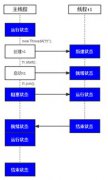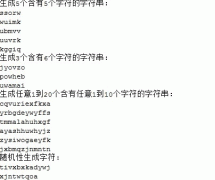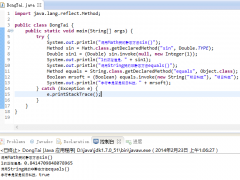java辨析(1):==和Equal.doc
? 总结
1、= =操作符比较的是操作符两端的操作数是否是同一个对象;另外= =操作符两边的操作数必须是同一类型的(可以是父子类之间)才能编译通过。
2、String的equals()方法比较的是两个String对象的内容是否一样
3、= =比较的是地址,假如是具体的阿拉伯数字的比较,值相等则为TRUE,如:
int a=10 与 long b=10L 与 double c=10.0都是相同的(为true),因为他们都指向地址为10的堆栈;如下题111;
? String s= "hello";
String t = "hello";
char c[] = {'h','e','l','l','o'}
Which return true?
A. s.equals(t);
B. t.equals(c);
C. s==t;
D. t.equals(new String("hello"));
E. t==c.
答案:(acd)
题目:哪些返回true。
这个在前面第10题的equals()方法和==操作符的讨论中论述过。==操作符比较的是操作符两端的操作数是否是同一个对象,而String的equals()方法比较的是两个String对象的内容是否一样,其参数是一个String对象时才有可能返回true,其它对象都返回假。需要指出的是由于s和t并非使用new创建的,他们指向内存池中的同一个字符串常量,因此其地址实际上是相同的(这个可以从反编译一个简单的测试程序的结果得到,限于篇幅不列出测试代码和反编译的分析),因此答案c也是正确的。
Given the following class:
public class Sample{
long length;
public Sample(long l){ length = l; }
public static void main(String arg[]){
Sample s1, s2, s3;
s1 = new Sample(21L);
s2 = new Sample(21L);
s3 = s2;
long m = 21L;
}
}
Which eXPression returns true?
A. s1 == s2;
B. s2 == s3;
C. m == s1;
D. s1.equals(m).
答案:(b)//D不对,只有String的equals()方法才比较值;
题目:给出下面的类: …
哪个表达式返回true。
前面已经叙述过==操作符和String的equals()方法的特点,另外==操作符两边的操作数必须是同一类型的(可以是父子类之间)才能编译通过。
再看以下几道
17. float f=4.2F;
Float g=new Float(4.2F);
Double d=new Double(4.2);
Which are true?
A. f= =g B. g= =g C. d= =f D. d.equals(f) E d.equals(g) F. g.equals(4.2);
答案:B
? 93. Click the exhibit button:
1. public class X {
2. public static void main (String[]args) {
3. String s1 = new String (“true”);
4. Boolean b1 = new Boolean (true);
5. if (s2.equals(b1)) {
6. System.out.printIn(“Equal”);
7. } 8. } 9. }
What is the result?
A. The program runs and prints nothing.
B. The program runs and prints “Equal.”
C. An error at line 5 causes compilation to fail.
D. The program runs but aborts with an exception.
答案:A
比较下题,小心使用equals 和 = =的区别;
? 93. Click the exhibit button:
1. public class X {
2. public static void main (String[]args) {
3. String s1 = new String (“true”);
4. Boolean b1 = new Boolean (true);
5. if (s2 = = b1) { //= =操作符两边的操作数必须是同一类型的(可以是父子类之间)才能编译通过
6. System.out.printIn(“Equal”);
7. } 8. } 9. }
What is the result?
A. The program runs and prints nothing.
B. The program runs and prints “Equal.”
C. An error at line 5 causes compilation to fail.
D. The program runs but aborts with an exception.
答案:C
? 111. Given:
1. public class Foo {
2. private int val;
3. public foo(int v) (val = v;) }
4. public static void main (String [] args) {
5. Foo a = new Foo (10);
6. Foo b = new Foo (10);
7. Foo c = a;
8. int d = 10;
9. double e = 10.0;
10. }
11. }
Which three logical expressions evaluate to true? (Choose Three)
A.(a ==c)
B.(d ==e)
C.(b ==d)
D.(a ==b)
E.(b ==c)
F.(d ==10.0)
答案:ABF //= =比较的是地址,他们都指向地址为10的堆栈;
Given the following code, what test would you need to put in place of
the comment line?
//place test here to result in an output of the string Equal
public class EqTest{
public static void main(String argv[]){
EqTest e=new EqTest();
}
EqTest(){
String s="Java";
String s2="java";//小心大小写
//place test here {
System.out.println("Equal");
}else
{
System.out.println("Not equal");
}
}
}
1) if(s==s2)
2) if(s.equals(s2)
3) if(s.equalsIgnoreCase(s2))
4)if(s.noCaseMatch(s2))
答案:3)//小心大小写





